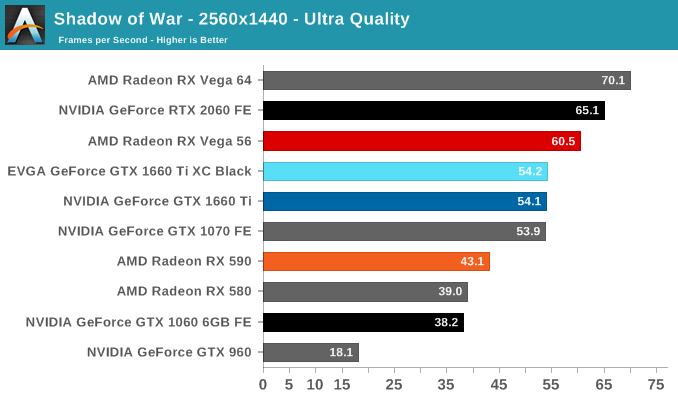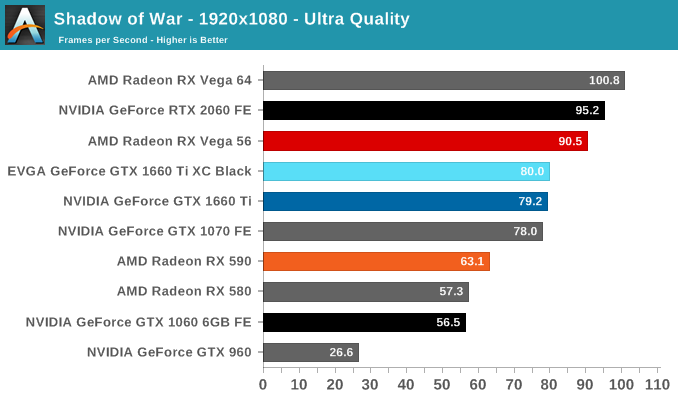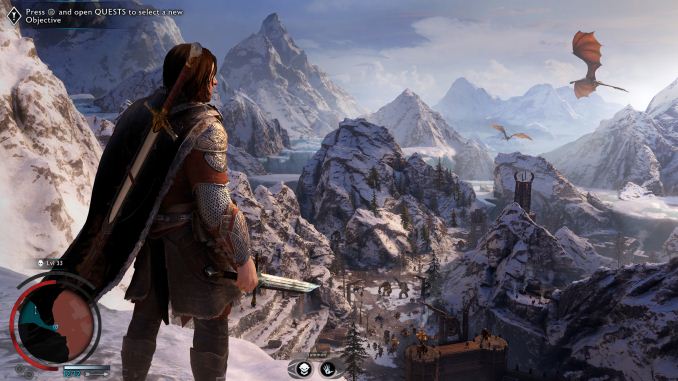The NVIDIA GeForce GTX 1660 Ti Review, Feat. EVGA XC GAMING: Turing Sheds RTX for the Mainstream Market
by Ryan Smith & Nate Oh on February 22, 2019 9:00 AM ESTMiddle-earth: Shadow of War (DX11)
Next up is Middle-earth: Shadow of War, the sequel to Shadow of Mordor. Developed by Monolith, whose last hit was arguably F.E.A.R., Shadow of Mordor returned them to the spotlight with an innovative NPC rival generation and interaction system called the Nemesis System, along with a storyline based on J.R.R. Tolkien's legendarium, and making it work on a highly modified engine that originally powered F.E.A.R. in 2005.
Using the new LithTech Firebird engine, Shadow of War improves on the detail and complexity, and with free add-on high resolution texture packs, offers itself as a good example of getting the most graphics out of an engine that may not be bleeding edge. Shadow of War also supports HDR (HDR10).
We've updated some of the benchmark automation and data processing steps, so results may vary at the 1080p mark compared to previous data.


Shadow of War is known to be a bit of a video memory hog, to which the GTX 960 acquiesces. Like Final Fantasy XV, the GTX 1660 Ti again finds itself bringing triple the performance. The GTX 1660 Ti opens a healthy lead here over the GTX 1060 6GB; if framebuffer is indeed a significant factor, it's important to note that the GTX 1660 Ti brings substantially more memory bandwidth to the table.











157 Comments
View All Comments
C'DaleRider - Friday, February 22, 2019 - link
Good read. Thx.Opencg - Saturday, February 23, 2019 - link
gtx at rtx prices. not really a fan of that graph at the end. I mean 1080 ti were about 500 about half a year ago. the perf/dollar is surely less than -7% more like -30%. as well due to the 36% perf gain quoted being inflated as hell. double the price and +20% perf is not -7% anandeddman - Saturday, February 23, 2019 - link
They are comparing them based on their launch MSRP, which is fair.Actually, it seems they used the cut price of $500 for 1080 instead of the $600 launch MSRP. The perf/$ increases by ~15% if we use the latter, although it's still a pathetic generational improvement, considering 1080's perf/$ was ~55% better than 980.
close - Saturday, February 23, 2019 - link
In all fairness when comparing products from 2 different generations that are both still on the market you should compare on both launch price and current price. The purpose is to know which is the better choice these days. To know the historical launch prices and trends between generation is good for conformity but very few readers care about it for more than curiosity and theoretical comparisons.jjj - Friday, February 22, 2019 - link
The 1060 has been in retail for 2.5 years so the perf gains offered here a lot less than what both Nvidia and AMD need to offer.They are pushing prices up and up but that's not a long term strategy.
Then again, Nvidia doesn't care much about this market, they are shifting to server, auto and cloud gaming. In 5 years from now, they can afford to sell nothing in PC, unlike both AMD and Intel.
jjj - Friday, February 22, 2019 - link
A small correction here, there is no perf gain here at all, in terms of perf per dollar.D. Lister - Friday, February 22, 2019 - link
Did you actually read the article before commenting on it? It is right there, on the last page - 21% increase in performance/dollar, which added with the very decent gain in performance/watt would suggest the company is anything but just sitting on their laurels. Unlike another company, which has been brute-forcing an architecture that is more than a decade old, and squandering their intellectual resources to design budget chips for consoles. :Pshabby - Friday, February 22, 2019 - link
We didn't wait 2.5 years for such a meager performance increase. Architecture performance increases were much higher before Turing, Nvidia is milking us, can't you see?Smell This - Friday, February 22, 2019 - link
DING !I know it's my own bias, but branding looks like a typical, on-going 'bait-and-switch' scam whereby nVidia moves their goal posts by whim -- and adds yet another $100 in retail price (for the last 2 generations?). For those fans who spent beeg-buckeroos on a GTX 1070 (or even a 1060 6GB), it's The Way You Meant to Be 'Ewed-Scrayed.
haukionkannel - Saturday, February 23, 2019 - link
Do you remember how much cpus used to improve From generation to generation... 3-5%...That was when there was no competition. Now when there is competition we see 15% increase between generations or less. Well come to the future of GPUs. 3-5 % of increase between generations if there is not competition. Maybe 15 or less if there is competition. The good point is that you can keep the same gpu 6 year and you have no need to upgrade and lose money.